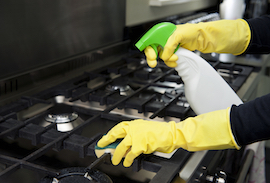As more chemicals are used in our homes and workplaces, it is important to know what substances are dangerous and how to avoid contamination. According a 2012 Poison Control Center report, pain medication, cosmetic and personal care items, and household cleaners were the substances most frequently involved in human exposures. The good news is that government regulators and private retail chains are helping to limit what gets used in the products we encounter daily.
Common cleaners are the number two cause of dangerous exposures in the United States.
In 2013, both Wal-Mart [download] and Target, two of the world’s largest retailers, announced ambitious sustainability plans. Both companies plan to bring increased transparency to the ingredients used in products and called for a reduction in especially harmful chemicals used in the products they sell. While the plans were aimed more generally at sustainability and reducing negative environmental impacts, both set strict guidelines for safer products.
The U.S. government has also joined the fight against hazardous chemicals and misleading ingredient labels. In early June, the U.S. House Committee on Energy & Commerce approved HR 2576, a bill that would expand the Toxic Substance Control Act of 1976 and allow the EPA to test for and regulate hazardous substances in consumer goods and products. The bill, if passed, would also allow the EPA to evaluate substances for unreasonably risky ingredients. It would also limit any state or local government's power in regulating a chemical substance that the EPA has determined safe under its intended uses.
You Should Know How to Avoid Contamination
While the government and private businesses work to make consumer goods safer, it is still important to always use caution when dealing with potentially dangerous chemicals. In 2013 the Center for Disease Control reported that there were 38,851 unintentional poisoning deaths that year alone. Never mix chemicals when cleaning, and always wear gloves and wash your hands thoroughly. Dangerous products are not limited just to cleaning supplies; others come in the form of carbon monoxide, lead paints, asbestos and other harmful building supplies, as well as cosmetics and lawn care products. To avoid these dangers, use carbon monoxide alarms, always have an inspector walk through and test any new building that you may be considering purchasing, and take extreme caution when using fertilizers and pesticides.
Storing Toxic Chemicals
Keeping chemicals locked away and out of the reach of youngsters and pets is paramount to preventing accidental contamination and poisonings. When storing hazardous chemicals and cleaning supplies, always:
• Keep chemicals in a well-ventilated area like a garage or shed;
• Read labels and follow directions accordingly;
• Store chemicals out of reach of children or pets;
• Store chemicals away from food storage;
• Be sure containers are sealed tightly before storing;
• Keep soaps and dental hygiene products out of the reach of young children;
• Lock medicines away if possible; and
• Always read and follow label instructions on proper storage.
If you are ever exposed to a dangerous chemical or have a question about a product or ingredient, call the Poison Control Center Hotline 24/7 at 1-800-222-1222
This article appeared in our September 2015 "You Should Know" e-newsletter.


